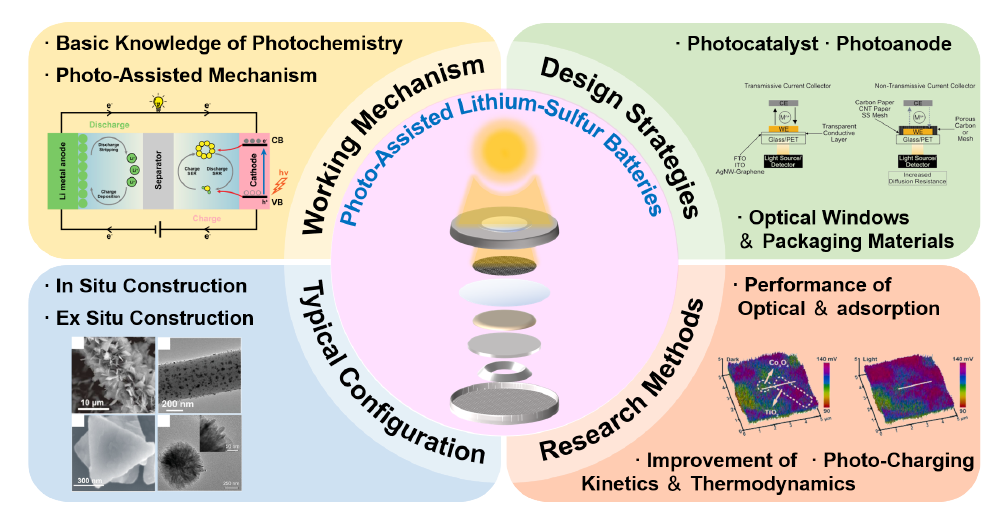 PDF(6119 KB)
PDF(6119 KB)


The Photo-Assisted Strategy for High Performance Lithium-Sulfur Batteries
Jia-Cheng Yu, Hao Su, Jun Zhang, Gang Xie, Ming Yao, Jin Qu
Prog Chem ›› 2025, Vol. 37 ›› Issue (4) : 467-478.
 PDF(6119 KB)
PDF(6119 KB)
 PDF(6119 KB)
PDF(6119 KB)
The Photo-Assisted Strategy for High Performance Lithium-Sulfur Batteries
Lithium-sulfur batteries are valued for their high theoretical specific capacity,energy density,and other advantages,but their commercialization is limited by the slow kinetics of sulfur species conversion and the "shuttle effect". In response,researchers have utilized the photocatalytic effect to develop a photo-assisted strategy for lithium-sulfur batteries,an emerging strategy that not only improves the adsorption and catalytic performance of the catalyst,but also enhances the battery performance in terms of both thermodynamics and kinetics,and even achieves the storage and release of solar energy through the photo-charging mechanism. In this paper,based on recently relevant studies,we introduce in detail the photoelectrochemical principles of photo-assisted lithium-sulfur batteries,discuss the design strategies of photocatalysts and photoanode,as well as the selection of optical windows and encapsulation materials,and review the typical configurations of photopositives and the research methodology of photo-assisted lithium-sulfur batteries,with the aim of attracting the extensive attention of our peers and providing references for the in-depth understanding and improvement of photo-assisted lithium-sulfur batteries.
Contents
1 Introduction
2 The working mechanism and design strategy of photo-assisted lithium-sulfur batteries
2.1 The photoelectrochemical principle of photo-assisted lithium-sulfur batteries
2.2 Design strategies of photo-assisted lithium-sulfur batteries
3 Typical configuration and research methods of photo-assisted lithium sulfur batteries
3.1 Typical configuration of photocathodes
3.2 Research methods for photo-assisted lithium-sulfur batteries
4 Conclusion and outlook

lithium-sulfur batteries / photo-assisted / photocatalysis / photo-charging / solar energy
| [1] |
|
| [2] |
|
| [3] |
|
| [4] |
|
| [5] |
|
| [6] |
|
| [7] |
|
| [8] |
|
| [9] |
|
| [10] |
|
| [11] |
|
| [12] |
|
| [13] |
|
| [14] |
|
| [15] |
(赖超, 李国春, 叶世海, 高学平. 化学进展, 2011, 23: 527.).
|
| [16] |
|
| [17] |
|
| [18] |
|
| [19] |
|
| [20] |
|
| [21] |
|
| [22] |
|
| [23] |
|
| [24] |
|
| [25] |
|
| [26] |
|
| [27] |
|
| [28] |
(周丽,
|
| [29] |
|
| [30] |
|
| [31] |
|
| [32] |
|
| [33] |
|
| [34] |
|
| [35] |
|
| [36] |
|
| [37] |
|
| [38] |
|
| [39] |
|
| [40] |
|
| [41] |
|
| [42] |
|
| [43] |
|
| [44] |
|
| [45] |
|
| [46] |
|
| [47] |
|
| [48] |
|
| [49] |
|
| [50] |
|
| [51] |
|
| [52] |
|
| [53] |
|
| [54] |
|
| [55] |
|
| [56] |
|
| [57] |
|
| [58] |
|
| [59] |
|
| [60] |
|
| [61] |
|
| [62] |
|
| [63] |
|
| [64] |
|
| [65] |
|
| [66] |
|
| [67] |
|
| [68] |
|
| [69] |
|
/
| 〈 |
|
〉 |